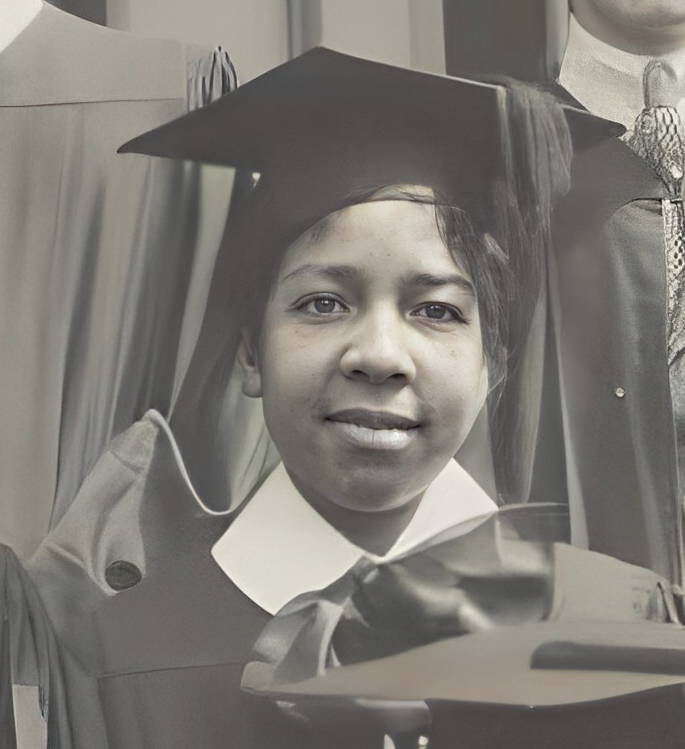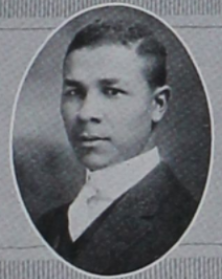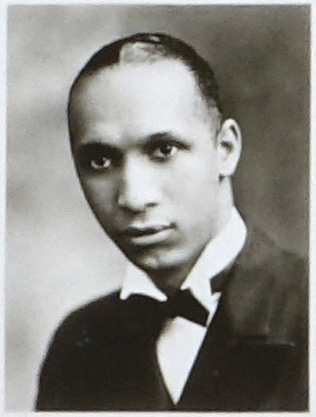Cora Mae Starland was born in Denver, Colorado, the daughter of Alberta R. Little Starland and Samuel W. Starland. The exact year of Cora Mae’s birth is unclear, as different documents list her birthdate as 19 February 1907 (her death record), 1903 (her marriage certificate), and ca. 1910 (the 1930 Census). Given that she graduated from high school in 1919, 1903 seems the most likely of these dates.
The Starlands moved their family to Ravenna, Ohio, shortly before they divorced and Alberta remarried to Claude Curtis. Cora Mae graduated from Ravenna High School in July 1919 and began work at the Annevar Mill that summer. There she put in 12-hour shifts working in the woolen mill (Gelber, 2022). While working there, Cora Mae met co-worker Anna Trice, mother of John G. “Jack” Trice.
In 1921, Jack Trice spent the summer in Ravenna and encountered Cora Mae Starland before returning in fall 1921 to Cleveland to finish his senior year at East Tech High School (Gelber, 2022). After Jack’s graduation in spring 1922, he moved to Ravenna and spent time with his mother and Cora Mae. As summer passed, Jack’s high school football coach Sam Willaman offered Jack the opportunity to play ball with him at Iowa State College while studying agriculture. Before Jack left for ISC, Cora Mae and he traveled to Monroe, Michigan, where they could be married quickly before Jack left for college. They married 27 July 1922 in Monroe, and the following September, Jack left for Ames and his first year at ISC, where he became a standout in freshman football and track and field. When he returned to Ravenna in summer 1923, the couple reunited, and Cora Mae joined Jack in Ames to begin their lives together (Gelber, 2022). She entered ISC as a home economics student in fall 1923. She also worked to help pay for the couple’s education since there were no athletic scholarships at that time.
A local Masonic group secured space for the couple to live at a local temple because they were unable to obtain housing on campus. Tragically, Cora Mae’s marriage to Jack was brief. Jack, a member of ISC’s varsity football team, died on 8 October 1923, from injuries sustained in an away game against the University of Minnesota in Minneapolis. Cora Mae later remembered Jack’s return to campus, injured, after the game, and how Jack’s fraternity brother Harold Tutt came to find her and delivered the message that she was to go to the campus hospital. There, she found her husband on the edge of death. As Cora Mae recalled, “I said, ‘Hello, Darling.’ He looked at me but never spoke. I remember hearing the Campanile chime 3 o’clock. That was October 8th, 1923, and he was gone” (Greene, 1988).
Following Jack’s memorial service on campus, Cora Mae and Jack’s mother, Anna, traveled with a funeral party, including Harold Tutt, back to Ohio to bury Jack in Hiram. By 1924, Cora Mae had moved back in with her mother and stepfather in Youngstown, OH. She had left ISC without her bachelor’s degree, though she did return to Ames and is listed in the 1925 Iowa State Census as residing with the Edwin Gater family, one of the first African American families in Ames and the family who had hosted the Ames Black community’s memorial service for Jack on 21 October 1923 (“Tribute Is Paid,” 1923).
Cora Mae married Homer Lee Greene on 24 November 1926. The couple had two daughters and a son, and Cora Mae kept house for her family.
Cora Mae Starland Trice Greene later lived in Los Angeles, California, before returning to Youngstown, Ohio, her old age. She died of a stroke on 26 December 1993 at the age of 86 (or older), leaving behind Mrs. Betty Armstrong of Youngstown, Mrs. Peggy Thomas of Pomona, California, and Homer Lee Greene, Jr., of Girard, Ohio. She had five grandchildren, seven great-grandchildren and a great-great-grandchild at the time of her passing. She is interred in the Pomona Valley Memorial Park, Pomona, CA, with her husband Homer (Find a Grave, 2016).
Sources
Photo credit: Cora Mae Starland. (1919). Private Collection of Leigh A. Greene, Courtesy of Ames History Museum.
Find a Grave, database and images. (2016, Nov. 9). Memorial page for Cora Mae Starlard Greene (19 Feb 1907–26 Dec 1993), Find a Grave Memorial ID 172487252. Retrieved from https://www.findagrave.com/memorial/172487252/cora-mae-greene. Maintained by Will Carrick (contributor 47399798).
Gelber, Jonathan. (1922). The idealist: Jack Trice and the battle for a forgotten football legacy. Triumph Books.
Greene, Cora Mae Starland Trice. (1988). Cora Mae Trice Greene letter to David Lendt, August 3, 1988, p. 4. Iowa State University Library Digital Collections. Retrieved from https://n2t.net/ark:/87292/w9dc8v
Tribute is paid to late football star: Negroes honor dead in fitting memorial service. (1923, Oct. 22). The Ames Daily Tribune and Ames Evening Times, p. 1. Newspaper Archive. Retrieved from https://newspaperarchive.com/ames-daily-tribune-and-ames-evening-times-oct-22-1923-p-1/



